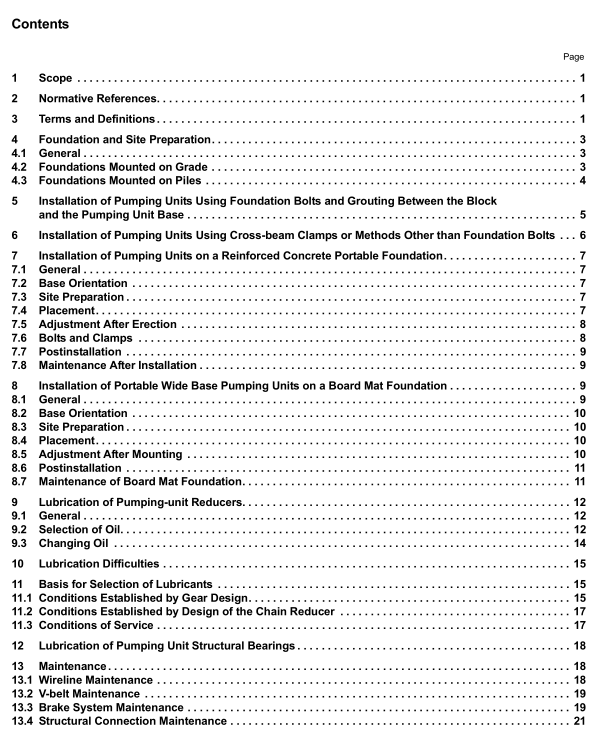API RP 11G pdf download

API RP 11G pdf download Recommended Practice for Installation, Maintenance, and Lubrication of Pumping Units
4 Foundation and Site Preparation
4.1 General The following discusses the typical role and requirements associated with the pumping unit foundation. It describes a general process of preparing a location to support a pumping unit installation. Pumping units, by their nature, transmit very large forces to the supporting earth. Foundations provide a means of distributing these forces over a broad area allowing the soil and underlayment to generate sufficient strength and stiffness to withstand them while yielding only very small deflections. The stability and rigidity provided by the foundation and the site preparations necessary to constrain movement are essential in maintaining proper alignment and providing the pumping unit with long operational life. Many times, structural failures involving pumping units can be traced back to an insufficient foundation or poor site preparation practices. The means by which pumping unit foundations transmit their loads into the earth take several forms ranging from simple surface contact with the underlying soil to driven or helical piles sunk deeply into the earth. In each case, the foundation must possess sufficient strength and stiffness to allow localized forces applied by the pumping unit to be adequately distributed over an area of soil contact or to a series of piers (piles) so that the local load bearing capacities of these elements are not exceeded.
It is also often necessary for the foundation to possess sufficient mass to constrain dynamic up-lifting forces produced by some pumping unit models and prevent degradation of the soil contact interface under the foundation. The mass of the foundation also helps to stabilize the unit against skidding. One area of particular importance is rigidity under load. The top surface of the foundation should remain as flat (planar) as possible under all operational loading conditions. The pumping unit base structure is typically clamped to the top surface of the foundation and excessive deflection can result in damage to the structural components or the pumping unit mechanism. The allowable deflection under load varies somewhat by pumping unit model but in general, the vertical deflections measured at the top surface of the foundation should not exceed 0.035 in. (0.9 mm) throughout the operating cycle. This measurement can be easily made using a dial indicator anchored on the ground while measuring at a point on the foundation surface.
4.2 Foundations Mounted on Grade
4.2.1 General Foundations of this type typically derive their support through a distributed area of contact with the earth. This includes poured in place reinforced concrete slabs, precast concrete slabs, board mats, and certain other integrated portable pumping unit base structures that are specifically designed for similar distributed load bearing capability. These foundations often do not require any other form of anchorage to fix their location relative to the earth. They are, however, highly reliant on proper site preparation to provide the necessary stability and strength to resist pumping unit forces over time.
4.2.2 Site Preparation Recommendations for Foundations Mounted on Grade
4.2.2.1 General The following requirements are performed for the initial site preparation.
— Contact a local geotechnical engineer to conduct an evaluation of the soil and installation site and provide a plan for preparations.
— Remove loose materials (scoria, etc.) surface vegetation, roots, and other organic materials from the soil that will underlie the pumping unit foundation.
— Excavate, back-fill, compact, and amend the soil with materials in accordance with the geotechnical engineering plan.
4.2.2.2 Site Drainage The foundation site should be elevated slightly relative to the surrounding area such that water will tend to drain away from the foundation. Do not allow water to pool adjacent to or drain across the site. 4.2.2.3 Soil Load Bearing Capacity The soil bearing strength should normally exceed 1500 lb/ft 2 (7323 kg/m 2 ).
Select foundation design with sufficient soil contact area to distribute pumping unit loads appropriately. If necessary, amend the soil with materials designed to increase the bearing capacity beneath the foundation as recommended by the geotechnical engineer. Soil pressure should not exceed that of the bearing strength in any location.
4.2.2.4 Soil Stiffness The required soil stiffness depends on the magnitude of the applied loads from the pumping unit, the ground contact area of the foundation, and the allowable vertical deflection of the foundation under load (see above). Pumping unit base loading information is typically available from the pumping unit manufacturer to use in selecting an appropriate foundation design.









